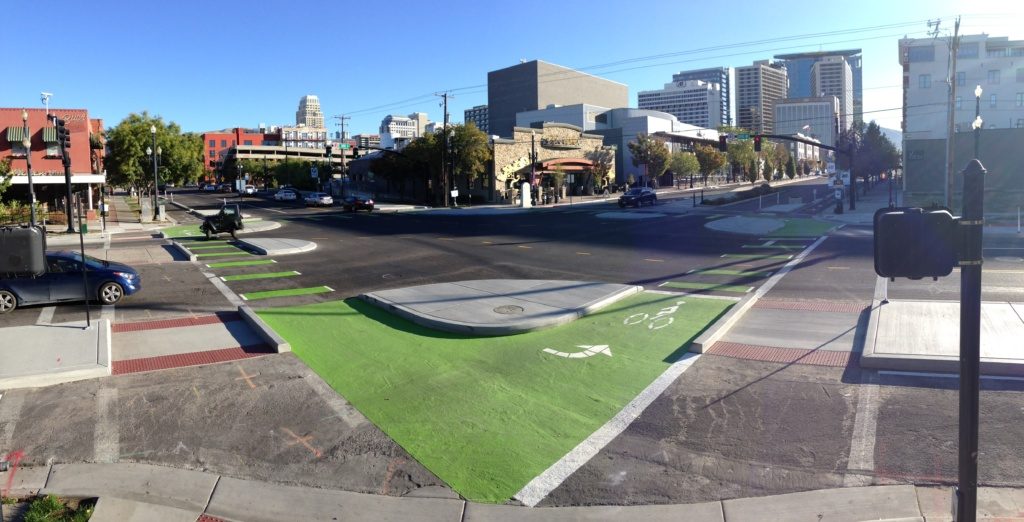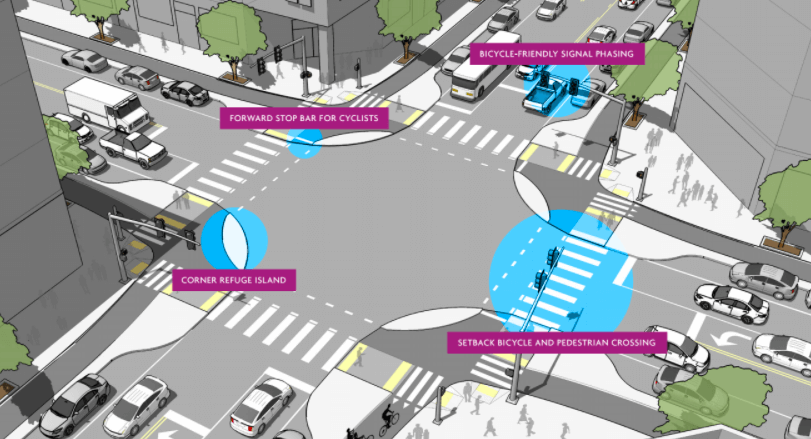The Cross Canada Cycle Tour Society January 2017, Volume 34, Issue #1
President’s Report John Pringle
The 2016 AGM– A brief Overview (Bet you can hardly wait to delve in)
Stormy weather & the Chapters Vote. For those gallant members (42 of you) who braved the strong winds, snow and below zero temperatures to attend the recent AGM, the Board thanks you muchly (2015 turnout was ~55 under rather benign weather conditions), so we “done good me hearty souls”. Board members worried we wouldn’t have a quorum (20 members in good standing), which would have rendered the planned essence of the meeting, a vote on chapter formation, a non-starter. But a quorum we had and the pitch and motion, “That we formally acknowledge the existence of ‘Chapters’ by identifying them in the CCCTS Registered Society Constitution and Bylaws”, was elegantly made by Ed Fudge. The AGM vote was unanimous. The Board’s work now begins. We have a preliminary timetable of activities to firm up, which includes the design and configuration of the six or so chapters (with the assistance of the chapter leaders), develop governance models for each chapter i.e. the leadership team recommended by each chapter, and rewrite a wee portion of the Constitution. The plan includes this being presented at the 2017 AGM, and if passed, our revised Constitution and Bylaws will be submitted to the BC Registrar of Societies. A time and workload challenge, that there is no doubt, but we feel strongly the changes will improve Club democracy, esprit de corps and most importantly, to better ensure insurance coverage of leaders.
A huge thank you was extended to Allan Buium, not only for his long serving membership on the Club Board (>three terms as President), but as a keystone contributor to our successful annual events (h & s and tours) program. Not only does he do much heavy lifting, but he contributes in many small ways as well, i.e. by driving Vancouver Island-based members from the ferry terminal to Board meetings; providing us with Solly’s cinnamon buns at meetings; assists in the loading/unloading of camping tour equipment for each camping tour; assists with Club storage facility clean-ups; and, as the Board’s Past President I’m frequently mining his corporate memory. His contributions just never stop. His concern for the Club’s welfare is deep rooted.
It was noted that 13 major events (six h & s and seven tours) were held this year. Each tour and h & s leader was thanked along with their respective Directors, Charlene Dorward and Bruce Daykin (he also led a most successful Rocky Mountain camping tour). Departing Board Members were thanked: Holly Evans, who will continue to assist Bruce McLean with Treasurer tasks; Al McLean, who will continue as Equipment Manager; Wayne Hanscom, who will continue as events auditor; and Clark Woodward who will continue to provide astute input to the Club leadership while Leader of the Chilliwack Chapter. In addition, our informal Area Representatives were thanked for their dedicated service to each of our six Areas. They include Barbara Fudge and Georgina Price, Barbara Wilson, Diane White, Alex Laird and Clark Woodland.
Goals for 2017 were outlined as follows:
- The rollout of the Chapters governance model will continue under the directorship of Ed Fudge;
- The construction of the website will continue under the directorship of Max McClanahan (he also co-ordinated the ground-breaking 2016 tour of Tanzania); and
- The thrust will continue to enhance major event numbers and entice new leaders for h & s and tours. Charlene and Bruce will continue as Directors on these files, and will lead discussions on techniques and approaches that might attract new event leaders.
Cycle Touring Clubs that provide a similar product as CCCTS were quickly reviewed and a challenge thrown out. These clubs are not numerous, but a couple of large, US-based clubs such as the Adventure Cycling Association (Missoula, MT) ( ~50,000 members and offer >100 tours/year) and the Bicycle Adventure Club (San Diego, CA; ~2,200 members and offer ~50 tours/year) do attract riders from the likes of smaller clubs such as ours. As well, private tour operators, abetted by improved, computer-based technologies, have grown in number. And despite their more expensive tours do compete for both cycling clubs’ members and for their experienced tour leaders. The British-based “Cycling UK”, which is a federation of UK cycling clubs, has a subsidiary organization “CTC Holidays” catering to both touring couples and families. They claim to offer up to 1,600 events/year! These three “clubs” have paid employees, but advertise non-profit status. To lure competent and experienced tour leaders they provide handsome monetary rewards. Given that CCCTS has members and chapters across Canada, might the Club emulate the federation style of the >100 year old Cycling UK? Chew on that over 2017.
A final pitch for 2016: With the departure of Clark Woodland, the Board urgently requires a Secretary. The Secretary will be a Board member. If interested, please contact Allan Buium (abuium@telus.net or 604-875-6335) or me (knitsui@telus.net or 778-533-1440).
A peaceful New Year to all.
Welcome New Members
| Dennis | Ford | Aitkenvale | Australia |
| Phyllis | Pryor | Albuquerque | USA |
| Richard | Flynn | Dartmouth | NS |
| Jane | Baker | Surrey | BC |
| Waldemar | Braul | Vancouver | BC |
| Sharon | Doiron | Whistler | BC |
Changes Planned for the CCCTS Web Site
In last month’s article we went through the current changes to the club web site. In this article we look a little further down the road toward what is planned for the web site in the coming months.
The goal of the planned changes is the integration of various management tools used by the club into a single tool. These changes will make it easier for our volunteers who manage the club. We also believe that — although all change comes with their challenges — the end product will be a system that is easier to use for the average member as well. The systems that are being integrated are the website, the club database and our registration system (Karelo). Our accounting systems will, for various reasons, remain separate.
The currently planned changes mostly are an effort to replace the services currently provided by Karelo. Karelo currently provides a number of important services to the club. These can broadly be broken down into 3 categories: Email services, Membership Registration, and Tour and Hub & Spoke Registration. Now that Club members have individual accounts on the web site (as they do on Karelo) we can proceed to provide these services ourselves.
Most of these new features will be accessible to you via a new “personal page”. When we introduce the personal page in the next few weeks it will show up as the first page that you see when you log into the web site. It will contain a number of tabs that will allow you to access all of the services currently provided by Karelo, as well as a few other new bits of functionality.
The club uses a number of email lists to communicate with the membership. The most obvious is the monthly newsbrief notices, but also mailings about other club-wide events and local events. For those members who have access to these mailing lists, we will provide direct access from the web site in the next few weeks. For the general membership we also hope to provide a new service. Under the email tab on your personal page there will be a simple form that allows you to send an email to any other member of the club. We will do this via a mechanism that sends the email without disclosing the recipient’s email address. This approach strikes a balance between respecting your privacy while enhancing the ability to communicate among the membership. We will also provide an opt-out mechanism for members who do not want to receive such emails.
Membership renewal will also be available via a tab on your personal page. When this comes online in the next few months we will be able to provide a much simpler renewal process. No separate login will be required. A few clicks, enter your credit card number and done. No need to re-enter information that has not changed.
Finally, Tour and Hub & Spoke registration will be available directly from our web site. Again, no separate login will be required. Just select the event you wish to register for, enter your credit card information and done. We hope this will greatly simplify the registration procedure and take some of the stress out of signing up for a ride.
Meet our members and e-Bikes
“Apparently it’s legal after 80 to use an e-bike!” Or at least that was the quote from Paul, who at 80 plus has both a regular and e-bike. Depending on the terrain, he chooses which works better for him, and he’s still able to join group rides, enjoy cycling and continue one of his favorite activities.
E-bikes are all the rage in Europe and the trend is catching on in North America.
But e-bikes are also for the under 80 crowd who for health reasons or challenging terrain might choose to benefit from the electric assist. Tom, for example hasn’t been able to cycle for 30 years, due to health concerns, but at 68 he’s rediscovered cycling with an e-bike. He modified a standard bike with a rear wheel motor drive and external battery.
My first introduction to e-bikes was with a bike shop mechanic, who commuted to jobs and school programs with an e-bike. It was faster than transit, driving or a regular bike, and allowed him more flexibility and efficiency on the job.
There are 2 main types, purpose built e-bikes or modifying a standard bike.
The main criteria for the e-bike you choose is battery life. What is the limit of the battery range for distance before recharging is necessary?
Weight and cost are also factors. E-bikes are heavy, the battery adds considerable weight. And costs tend to be higher because of the battery addition and different modifications required from a basic bike. Demand to date has been limited, but that too is changing.
Have you considered an e-bike in your future?
An excellent resource is from Momentum, the magazine, The E-Bike Guide.
Upcoming Hub and Spokes
Upcoming Tours
- 2017 Portland
- 2017 BC Lakes and Mountains
- 2017 Italy Appenines to Adriatic
- 2017 Ireland – Wild Atlantic Way
- 2017 Munich to Venice
- 2017 Ottawa Valley
Protected Intersections: The Latest Trend in Cycling Safety
“Cities across North America are investing heavily in protected bike lanes to increase bicycle ridership but a bikeway is only as good as its weakest link.”
Written by: Momentum Staff Photo courtesy of Alta Planning
Protected bike lanes (cycle tracks) are the new gold standard for cycling safety in North America, but they have one significant flaw. When the buffer ends at the intersection, people on bikes are spit back out into space for vehicles, resulting in a confusing and stressful remixing of traffic modes that all too often ends in collisions. So while planners and policy makers rush to install protected bike lanes, another trend in cycling safety is quietly taking root.
The protected intersection extends the physical barrier of the protected bike lane into the intersection, creating a clear and safe, continuous path of travel for all modes. “Cities across North America are investing heavily in protected bike lanes to increase bicycle ridership but a bikeway is only as good as its weakest link,” explained Nick Falbo, the Portland-based urban planner responsible for coining the term ‘protected intersection’. “The intersection must feel as safe and secure as the protected bike lane itself.” The crossings are modeled after typical Dutch road junctions, but only when Falbo created a video explaining how they work did the idea began to resonate with North American policy makers.
Protected intersections have four main design elements: a corner refuge island, a forward stop bar for cyclists, a setback bicycle and pedestrian crossing, and bicycle-friendly signal phasing. The corner refuge island is a physical barrier that protects people on bikes from cars making turns. After yielding to pedestrians, cyclists can either turn right safely or continue into the intersection past the crosswalk to the forward stop bar, where they can wait at a red light buffered from vehicles by the refuge island. This has many advantages: bike are positioned well in front of cars while at a red light and therefore their visibility is dramatically increased. During that time, pedestrians are free to cross the street uninterrupted. When the light turns green, bicyclists are given a head start from cars and the distance of unprotected road they have to cross is greatly reduced. The setback pedestrian and bicycle crossing created by the corner refuge island means motorists do not turn into their blind spot.
In a standard intersection, motorists can easily make a right turn and hit someone who is walking or bicycling in the driver’s blind spot, but a protected intersection moves the pedestrian crossing and the bike lane back by a distance of one car length. This means that any motorist making a right turn will have to turn 90 degrees to face the crosswalk and bike lane, reducing their speed and giving everyone time to be aware of and react to other road users, thereby seriously minimizing the risk of a collision. The most bicycle-friendy signal phasing would be completely separate crossing times for people on bikes and people driving (protected phasing). However, even delaying green lights for drivers to give people on bikes a slight time advantage when entering the intersection helps (lag time for cars, lead time for bikes).
“The protected intersection aims to create conditions that are forgiving of mistakes,” Falbo explained. “The added separation between users and slow-speed road design allow people driving and people bicycling to respond to potentially dangerous situations. When paired with protected bicycle signals, conflicts can be eliminated.” While there are some real challenges – such as accommodating the wider turning radius of large trucks – they are problems which careful design efforts can overcome. Even with the reduced traffic speeds improving safety for all ages and abilities, protected intersections are likely to have a minor effect on overall traffic flow, if any at all. “Every city implementing networks of protected bike lanes will need to answer the question of what to do at intersections,” Falbo said. “The protected intersection is one potential solution.”
Newsbrief
Published at least ten times a year by The Cross Canada Cycle Tour Society, a non – profit organization for retired people and others who enjoy recreational cycling. The NEWSBRIEF is available, in colour, to paid up members, on the CCCTS website.
Items for the NEWSBRIEF must be received by the 28th of the month. The Editor reserves the right to edit for clarity, brevity and suitability of publication. The views expressed in “NEWSBRIEF” are not necessarily those of the CCCTS or the Editor.
Submissions for NEWSBRIEF should be emailed to jklein@3web.com or derailler@gmail.com
Please be sure to notify the office of any changes in your personal contact information; be it address, phone or e-mail.



